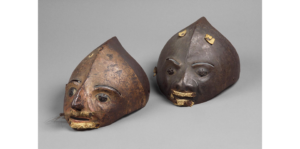Hussar armor, masks, and shields

Hungarian treasures in the world
(Kunsthistorisches Museum Wien, Hofjagd- und Rüstkammer, Austria)
Hungarian Hussar mask for tournaments, 1557
It is described like this:
„The mask visors – in modern tournament descriptions they are also called “Larffen” – were important props for the so-called “Husari” or “Hungarian” tournament. In these disguised or masked tournaments, one party in a hussar attire faced a person disguised as Ottomans and Moors.
The Hussars, a Hungarian elite unit, were recognized as defenders of the empire in the east against the Ottomans; they appeared in the Hungarian colors red-white-green and wore Hungarian sabers, longspurs, winged as well as the long, hollow horsemen of Eastern European or Turkish lancers, so-called “copi”.
During his governorship in Bohemia (1547-1564), Archduke Ferdinand II organized numerous Hussar tournaments, which served as a means of political propaganda against the real political background of the danger of the Turks threatening from the east.
This propaganda was reinforced by the “visual imagination” using masking and disguise. Made of iron and painted with oil color change sights imitated the physiognomy of the “Moors” and “Hussars” at the tournament. Cut-out eyebrows served as viewing slits, and the painted eyes of the masks are provided with air holes. A riveted leather band above the mouth opening was intended to attach the characteristic long mustache of the hussars; it consists of horsehair here.
On the sides and top are leftovers of riveted leather straps to which a helmet, turban, or “Hungarian hat” could be attached. The masks were made in Prague. Incidentally, even in tournaments, Archduke Ferdinand II often occurred in the role of a hussar.
Currently not exhibited.”
Hussar shield (cc 1550)
This wooden-leather shield used to belong to a Hungarian hussar cavalryman. Now, it is in the Kunsthistorisches Museum Wien, Hofjagd- und Rüstkammer, Austria.

A Hungarian Tartsche “tárcsa pajzs” – Hussar shield, cc 1515


The main surface is adorned with a blackened line etching with the shooting of the bow, an allegory of the plague, which is closely related to Dürer’s fourth woodcut of his Apocalypse series that he created in 1498.

You can read more about the connection between Dürer and Hungary here:
https://www.hungarianottomanwars.com/essays/albrecht-durer-1471-1528-and-hungary/
A Hungarian-Style Shield ca. 1500–1550 from Eastern Europe

During the 16th century, the style was adopted across much of Eastern Europe by both Christian and Islamic horsemen. The shield’s elongated upper edge was designed to defend the back of the head and neck against cuts from a saber, the preferred cavalry weapon in that region.

Breastplate, a Hussar’s Cuirass, c. 1580 Hungary, 16th century




A round shield from the second half of the 17th century

Hungarian Gountlets of Mail
Date: 17th century; Culture: Hungarian; Medium: Steel, gilding; Dimensions: 29.158.196a: L. 12 3/8 in. (31.4 cm); Wt. 9.9 oz. (281 g); 29.158.196b: L. 12 in. (30.5 cm); Wt. 9.6 oz. (271 g) They are in the Metropolitan Museum of Art, in New York City (not in view).

From about the third century B.C. through the early fourteenth century A.D., mail, also called chain mail, was the predominant and most effective type of body armor known in Europe. From about the mid-fifteenth century onward, mail was used in conjunction with full-plate armor to fill the gaps between plates.
 Separate mail sleeves were made to be worn with a cuirass (breastplate and backplate); shaped panels of mail called gussets, covered the armpits or the crooks of the elbows and were attached to arming jackets, garments specially tailored to be worn under armor; and mail breeches, called brayettes or pairs of paunces, could be worn by men fighting on foot.
Separate mail sleeves were made to be worn with a cuirass (breastplate and backplate); shaped panels of mail called gussets, covered the armpits or the crooks of the elbows and were attached to arming jackets, garments specially tailored to be worn under armor; and mail breeches, called brayettes or pairs of paunces, could be worn by men fighting on foot.
Dear Readers, I can only make this content available through small donations or by selling my books or T-shirts.
If you like my writings, please feel free to support me with a coffee here:
You can check out my books on Amazon or Draft2Digital, they are available in hardcover, paperback, or ebook:
https://www.amazon.com/dp/198020490X
or at https://books2read.com/b/boYd81


My work can also be followed and supported on Patreon: Become a Patron!http://Become a Patron!

https://hungarianottomanwars.myspreadshop.com/all



